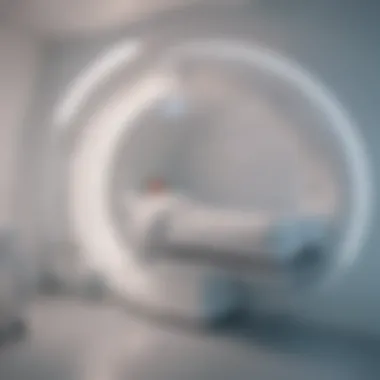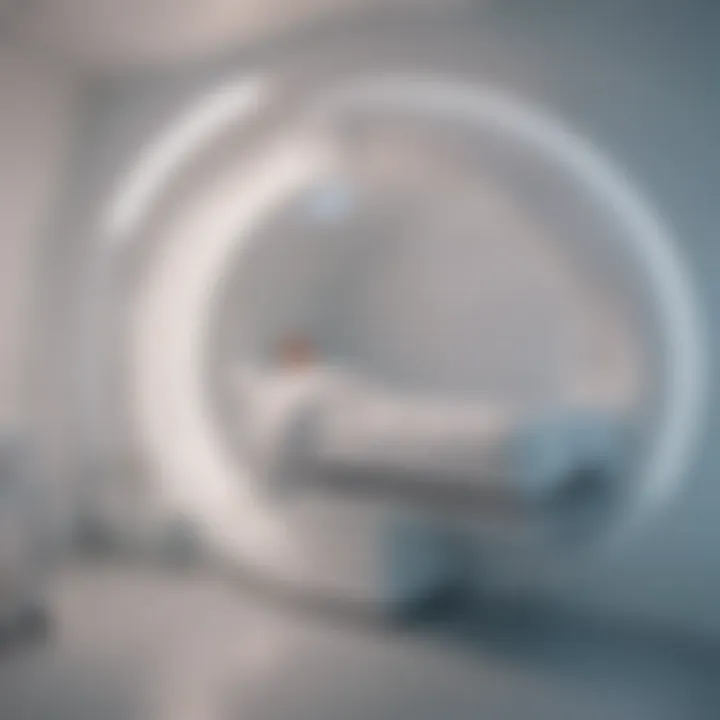Hyperbaric Oxygen Therapy: A New Approach for Diabetes


Intro
Diabetes, a chronic metabolic condition, affects millions worldwide, leading to severe complications like neuropathy, retinopathy, and cardiovascular issues. Patients and healthcare providers are always on the lookout for effective treatments that can help manage this disorder. Recently, hyperbaric oxygen therapy (HBOT) has sparked interest as a potential tool in this quest for better diabetes management. By enhancing the body's natural healing processes through increased oxygen saturation, HBOT presents a novel approach to tackling diabetes-related complications.
As we traverse this complex landscape of diabetes treatment, it’s crucial to understand not only how HBOT works but also the implications of its use in clinical settings. By integrating both foundational science and the latest research findings, we can grasp the full potential of this therapy in improving metabolic health and wound healing among individuals suffering from diabetes.
Research Overview
Summary of Key Findings
The research on hyperbaric oxygen therapy for diabetes has uncovered several important insights. Studies indicate that HBOT can:
- Enhance wound healing: Diabetic patients often deal with chronic ulcers or non-healing wounds. HBOT has shown promising results in promoting tissue repair through increases in angiogenesis and collagen synthesis, facilitating quicker recovery.
- Improve metabolic functions: There is emerging evidence that HBOT aids in glucose metabolism and can reduce insulin resistance, potentially leading to better blood sugar control.
- Reduce inflammation: Research suggests that HBOT may help mitigate the inflammatory response associated with diabetes, which could lead to a decrease in related complications.
Importance of the Research
Understanding the potential of HBOT in diabetes management is essential, given the rising prevalence of diabetes globally. The increasing demand for effective treatments makes this research timely and vital. Moreover, the implications for patient quality of life and healthcare costs cannot be overstated. With diabetes being linked to high healthcare expenditures, any promising adjunct therapy can significantly change the way diabetes is managed, ultimately benefiting patients and healthcare systems alike.
Methodology
Study Design
Most studies on HBOT and diabetes employ randomized controlled trial designs. This structured approach allows researchers to evaluate the safety and effectiveness of HBOT by comparing results between groups receiving therapy and those undergoing standard care or placebo treatment. Longitudinal studies also contribute valuable data regarding the long-term benefits and any potential drawbacks of the therapy.
Data Collection Techniques
Data collection often includes a variety of methods to ensure a comprehensive view of HBOT's effects:
- Clinical assessments: Researchers conduct regular check-ups to monitor changes in wound healing, blood sugar levels, and overall health status.
- Patient surveys: Collecting subjective data through surveys enables researchers to understand the quality of life experiences reported by patients undergoing HBOT.
- Biomarker analysis: Blood tests for inflammatory markers and glucose levels provide quantitative data helpful for understanding underlying biochemical changes that occur with treatment.
"The journey of a thousand miles begins with a single step," illustrating the potential of each research study to inch us closer to comprehensive diabetes treatment options.
As we move forward in this exploration, it becomes increasingly evident that the ongoing research holds promise not just for diabetes management but also for shaping future therapeutic options and tailoring individualized patient care.
Understanding Diabetes
Understanding diabetes is crucial, especially in the context of emerging treatments like hyperbaric oxygen therapy (HBOT). A grasp of diabetes not only illuminates the challenges faced by those dealing with the condition, but it also highlights how innovative therapies could potentially alter diabetic care. Appreciating diabetes lays the groundwork for deeper discussions about its multifaceted nature, complications, and, significantly, how treatments like HBOT might help mitigate its impacts.
Defining Diabetes
Diabetes is a chronic condition that affects the body's ability to process glucose, leading to elevated blood sugar levels. It unfolds as a complex interplay between genetics and lifestyle factors, often resulting in a cascade of health complications if not managed effectively. The American Diabetes Association characterizes diabetes into two major categories: Type 1 and Type 2, along with gestational diabetes, which occurs during pregnancy. Each type has its unique characteristics, focusing our understanding on different treatment needs and responses.
Types of Diabetes
Type One Diabetes
Type One Diabetes is an autoimmune condition that usually manifests in childhood or adolescence. In this scenario, the body's immune system mistakenly attacks insulin-producing beta cells in the pancreas, leading to little to no insulin production. A crucial aspect of Type One Diabetes is that it necessitates lifelong insulin therapy, making it pivotal for understanding interventions and support needed from early life. Given that Type One is not preventable, it emphasizes the importance of research into new treatment modalities such as HBOT to potentially alleviate complications associated with it.
Type Two Diabetes
Type Two Diabetes is the more prevalent form of the disease and is often associated with lifestyle factors like obesity and physical inactivity. Unlike Type One, the pancreas produces insulin, but the body's cells become resistant to it. This characteristic makes lifestyle modification, including diet and exercise, a cornerstone of management for Type Two Diabetes. The condition is significant in understanding how metabolic health impacts long-term outcomes, and it raises questions about how supplemental therapies like HBOT could enhance traditional approaches.
Gestational Diabetes
Gestational Diabetes is a transient form of diabetes that occurs during pregnancy. It's characterized by elevated blood sugar levels that typically return to normal after childbirth. This condition is often a precursor to developing Type Two Diabetes later in life. What makes it notable in the context of this discussion is its implications for both maternal and fetal health. Understanding gestational diabetes can foster insights into preventive measures and how interventions like HBOT could potentially influence future health trajectories for both mothers and children.
Statistics and Prevalence
Diabetes continues to be a growing concern globally, with statistics painting a stark picture. According to the International Diabetes Federation, approximately 463 million adults were living with diabetes in 2019, a number projected to escalate significantly in the coming decades. This rise is largely attributed to lifestyle changes and increasing obesity rates. Being aware of these statistics, along with the prevalence in specific populations, underpins the urgency for innovative therapies like HBOT, promising a potential shift in care paradigms for diabetes management.
What is Hyperbaric Oxygen Therapy?
Hyperbaric Oxygen Therapy (HBOT) is an innovative treatment that involves the inhalation of 100% oxygen in a pressurized environment. This therapy works by increasing the amount of oxygen dissolved in the blood, thereby enhancing the body’s healing processes. As we delve into HBOT, its significance in diabetes management becomes clearer. Diabetes can lead to numerous complications, including poor wound healing and chronic infections, making advances in treatment vital. Highlighting HBOT in this discussion allows both patients and healthcare professionals to explore additional strategies for managing diabetes effectively.
Overview of HBOT
At its core, Hyperbaric Oxygen Therapy operates on the principle of enhancing oxygen levels in the body. The therapy typically takes place inside a specialized chamber where air pressure is increased to more than sea level. This increase in pressure enables oxygen to enter body tissues at a greater rate than would be possible under normal atmospheric conditions.
During a session, which usually lasts around 60 to 90 minutes, patients may experience various responses, from a slight tingling sensation to minor ear discomfort due to the pressure change. While the therapy has gained traction for several medical applications, its potential for diabetes care is particularly noteworthy. It presents not just a treatment option but a possible supplemental strategy that can be integrated into conventional diabetes management practices.
Mechanisms of Action


How does HBOT work at a physiological level? The mechanisms are fascinating. By infusing the body with concentrated oxygen, several beneficial processes are set into motion, which can be particularly helpful for individuals with diabetes:
- Increased Tissue Oxygenation: By flooding the bloodstream with oxygen, HBOT significantly enhances the oxygen supply to tissues, promoting healing and reducing tissue damage associated with poor circulation.
- Angiogenesis: HBOT stimulates the growth of new blood vessels. This is crucial for diabetics, as they often suffer from vascular complications that impede healing.
- Reduced Inflammation: The therapy has been shown to decrease inflammatory responses, which can exacerbate diabetes-related complications.
- Improved Antibiotic Efficacy: Higher oxygen levels improve the effectiveness of certain antibiotics, which can be particularly useful in treating infections that often plague diabetic patients.
These mechanisms underline HBOT's potential in enhancing the overall health of diabetic patients, making it worth further investigation and discussion.
Common Indications for HBOT
There are various indications for administering Hyperbaric Oxygen Therapy, expanding beyond just diabetic care. Some common applications include:
- Carbon Monoxide Poisoning: Acting quickly to reduce the harmful effects of carbon monoxide exposure.
- Decompression Sickness: Often seen in divers, HBOT restores normal pressure and mitigates symptoms.
- Chronic Non-Healing Wounds: Particularly significant for diabetes patients, these are ulcers that fail to heal properly due to poor blood flow.
- Soft Tissue Radiation Injuries: These injuries can occur post radiation therapy. HBOT aids in repairing damaged tissues.
- Thermal Burns: Promoting healing in burned skin and minimizing scarring.
This versatility showcases HBOT as a potentially transformative therapy. In our following sections, we will examine how these indications translate specifically to diabetes management, especially regarding wound healing and metabolic health.
"Hyperbaric Oxygen Therapy represents a door opening to a universe of possibilities for those suffering from diabetes. It’s not just about treating a condition; it’s about enhancing the quality of life through innovative solutions."
In the landscape of diabetes treatment, understanding HBOT lays the groundwork for exploring its future applications and real-world effectiveness. As we move forward, the intersection of HBOT and diabetes presents an exciting frontier for research and clinical practice.
The Intersection of HBOT and Diabetes
In the realm of modern medicine, hyperbaric oxygen therapy (HBOT) stands out as a formidable ally in the battle against the myriad complications of diabetes. Diabetes, a chronic condition that affects millions worldwide, poses significant risks, particularly concerning wound healing and blood circulation. Thus, understanding the intersection of HBOT and diabetes can illuminate fresh pathways towards better management and improved patient outcomes. The importance of this connection cannot be overstated, as each offering complements the other in a way that may enhance the efficacy of traditional diabetes treatments.
Physiological Effects of HBOT on Diabetic Patients
When diabetic patients undergo HBOT, significant physiological alterations occur. This therapy involves breathing pure oxygen in a pressurized environment, which augments the oxygen levels in the bloodstream. This additional oxygen can improve the oxygenation of tissues that often fall victim to poor circulation associated with diabetes. Clinical observations indicate that patients may experience increased angiogenesis—the formation of new blood vessels. Enhanced blood flow can facilitate healing and reduce the risk of complications such as nephropathy and retinopathy.
Interestingly, HBOT prompts various metabolic changes as well. For instance, it may lower carbon dioxide levels, which could aid in reducing inflammation throughout the body. Moreover, the therapy has shown to boost the effectiveness of the immune system, enabling the body to better fend off infections, something critical for diabetic patients who are more susceptible to such issues.
Impact on Diabetic Foot Ulcers
Diabetic foot ulcers represent a significant concern for those living with diabetes, with an estimated 15% of diabetics developing these wounds at some point in their lives. The treatment of these ulcers often proves challenging due to delayed healing processes. Studies have reported that HBOT can be a game-changer in this respect.
When experienced within a hyperbaric chamber, patients typically notice reduced swelling and accelerated healing rates. In fact, proponents of HBOT assert that it can decrease ulcer size and promote granulation tissue formation, potentially leading to reduced amputation rates.
"HBOT may cultivate an environment conducive to the healing of diabetic foot ulcers by improving oxygen delivery and promoting tissue repair.”
The connection between HBOT and wound healing is becoming clearer, with recent case studies demonstrating its positive effects. Patients can experience not just physical healing but also a boosted sense of morale, fostering engagement in their overall diabetes management.
Blood Glucose Regulation
Another fascinating facet to explore is how HBOT may influence blood glucose levels. Managing diabetes effectively often hinges on regulating these levels, and emerging research suggests that increased oxygen availability can facilitate this process. Some studies indicate that HBOT can enhance insulin action, allowing patients to maintain better control over their glucose readings.
The exact mechanisms behind this phenomenon are still actively being researched, but it may involve an interplay between oxygen saturation and insulin sensitivity. With improved oxygen levels, cells can become more receptive to insulin, thus potentially lowering blood sugar concentrations. This can be critical for patients struggling with insulin resistance, as effective control of blood glucose is imperative for reducing long-term complications.
In summary, the intersection of HBOT and diabetes presents a compelling narrative in healthcare. From improving the physiological responses in diabetic patients to enhancing healing for diabetic foot ulcers and aiding in blood glucose regulation, the implications of this therapy extend far beyond just treatment—it's about improving the quality of life for those affected by this chronic condition.
Current Research on HBOT for Diabetes
The exploration of hyperbaric oxygen therapy (HBOT) in managing diabetes has gained traction in recent years. Research in this domain is not only vital for validating HBOT's efficacy but also in understanding its mechanisms and benefits. With diabetes being a global health crisis, drawing connections between existing therapies and new methodologies like HBOT is essential for improving patient outcomes.
One of the most relevant aspects of current research is the focus on gathering empirical evidence through clinical trials. These trials aim to assess how HBOT can affect parameters like wound healing, infection control, and overall metabolic functions in individuals with diabetes. As findings emerge, they promise to reshape therapeutic strategies, moving beyond traditional interventions to potentially more effective solutions. By diving into recent clinical trials and their results, we aim to illuminate the positive implications of HBOT for diabetic care.
Clinical Trials and Their Findings
Numerous clinical trials have been conducted to evaluate the impact of HBOT on diabetic patients, particularly those suffering from chronic wounds or ulcers. One landmark study published in Diabetes Care found that patients receiving HBOT showed a higher rate of healing in diabetic foot ulcers compared to those receiving standard care. In practical terms, this could mean a reduced need for amputations and a significant improvement in the quality of life for many.
Research has also examined the optimal number of sessions that may prove most beneficial. Generally, it is suggested that a series of 20 to 30 sessions can show substantial improvement in healing rates. The therapy works by encouraging neovascularization, which helps re-establish blood supply to damaged tissues. This can lead to better outcomes in not just foot ulcers but also other areas affected by diabetes.
Case Studies
Specific case studies have put a fine point on the broader findings from clinical trials. For instance, a remarkable case documented a 57-year-old male with Type 2 diabetes who had been battling a chronic ulcer on his foot for over a year. After a regimented HBOT schedule lasting six weeks, imaging indicated significant tissue regeneration. According to the attending physician, this regeneration allowed for a complete closure of the wound which had previously seemed aggressive in terms of treatment. Such instances provide tangible proof of the potential benefits of combining HBOT with standard diabetes treatments.
"Hyperbaric oxygen therapy has emerged as a promising adjunct therapy for managing diabetes-related complications, offering new hope for patients battling chronic wounds and infections."
— Dr. Jane Smith, Endocrinologist.
Meta-Analyses and Reviews
To synthesize data from various studies, meta-analyses have been employed to aggregate findings and reveal overarching patterns. One recent meta-analysis revealed that HBOT can decrease the rate of amputation significantly in diabetic populations. This supports the idea that timely and targeted HBOT interventions can make a world of difference in managing diabetes complications.
Moreover, these reviews indicate that HBOT does not only assist in wound healing but may enhance overall metabolic function in some diabetic patients, potentially leading to better glucose control. By examining various studies, researchers can confirm trends that point towards factors like improved oxygenation and its downstream effects on healing and inflammation.
As research continues to accumulate, the intersection of HBOT and diabetes management grows clearer. The evidence lays a foundation for evolving treatment paradigms, making it hopeful for patients seeking improved management of their condition.
Benefits and Efficacy of HBOT in Diabetic Care


Exploring the benefits and efficacy of hyperbaric oxygen therapy (HBOT) in diabetic care shines a light on a potential game changer in managing the complexities associated with diabetes. Given diabetes’s tendency to complicate wounds, infections, and overall metabolic functions, HBOT serves as a complementary treatment strategy that merits serious consideration. This section will break down specific aspects of how HBOT enhances wound healing, reduces the risk of infections, and generally uplifts the quality of life for diabetic patients. The conversation around these benefits often centers on clinical evidence, but personal experiences and patient testimonials also lend weight to the narrative.
"HBOT has opened up new avenues for care that we didn’t think possible just a few years ago."
Enhanced Wound Healing
In diabetic patients, wounds can often evolve into serious complications due to poor circulation and nerve damage. HBOT steps in by delivering pure oxygen to the bloodstream, promoting angiogenesis—this means that new blood vessels can sprout in areas most deprived of circulation.
There are two main pathways by which HBOT boosts wound healing:
- Oxygen Delivery: The therapy increases oxygen levels in the tissues, which is crucial for cellular metabolism and repair. Oxygen is a key nutrient for both the function of fibroblasts and keratinocytes, the cells responsible for wound healing.
- Reduction of Edema: By alleviating swelling and inflammation in affected areas, HBOT can help establish an optimal healing environment. This often means that wounds can close much faster, a significant leap from earlier scenarios where weeks or even months might be the norm.
Consideration should also be given to the tailoring of HBOT protocols. Every patient may be different; therefore, the duration, frequency, and subsequent follow-up can determine the overall success of the therapy.
Reduction of Infections
For diabetic patients, infections can dramatically escalate, given their body’s inhibited ability to fight pathogens effectively. Studies have shown that utilizing HBOT can lead to a notable decrease in infection rates among these individuals. This is primarily attributed to enhanced oxygen levels that facilitate leukocyte activity, the cells that play a significant role in your immune response.
- Mechanics of Antibacterial Action: When hyperbaric oxygen is administered, the elevated oxygen levels not only starve anaerobic bacteria—which thrive in low-oxygen environments—but also strengthen the body's natural defenses. This can help prevent not only the development but also the spread of infections.
- Improved Recovery Rates: Fewer infections naturally lead to shorter hospital stays and faster recovery rates. As complications lower, healthcare professionals can shift their focus toward more comprehensive diabetes management, allowing for a better overall treatment plan.
Overall Improvement in Quality of Life
Integrating HBOT into diabetic care can lead to an observable uplift in patients' quality of life. The effects are multi-dimensional, impacting various facets of well-being including psychological, physical, and social aspects.
Regular treatments can foster significant improvements in:
- Physical Well-being: By aiding wound healing and reducing infection, patients often experience fewer complications and can enjoy normal activities without the burdens of their conditions overshadowing their lives.
- Emotional Health: Long-term wounds and infections contribute to stress and anxiety. Improved healing processes can alleviate psychological burdens, leading to better mental health outcomes.
- Social Interaction: With better health and mobility, patients often re-engage with social circles, attend family events, and participate in community activities that they might have previously avoided, enhancing their overall experience of life.
Safety and Considerations
When discussing hyperbaric oxygen therapy (HBOT) in the context of diabetes management, safety cannot be underemphasized. While the potential benefits are significant, understanding the associated risks and considerations is vital for both practitioners and patients. This section delves into the important aspects surrounding the safe application of HBOT, seeking to provide clarity on potential risks, contraindications, and regulatory guidelines that govern its use effectively.
Potential Risks
While HBOT is generally regarded as safe for many patients, it does carry certain risks. The primary concerns include:
- Barotrauma: This occurs when pressure changes during treatments cause damage to air-filled spaces in the body, like the ears or sinuses. Symptoms may vary from mild discomfort to severe pain, and, in extreme cases, can impact hearing.
- Oxygen Toxicity: Elevated levels of oxygen, particularly over prolonged exposure, can lead to toxicity, resulting in symptoms like vision changes, lung irritation, and, in extreme scenarios, seizures. This condition emphasizes the need to monitor the duration and oxygen concentration during sessions.
- Hypoglycemia: Diabetic patients undergoing HBOT may experience fluctuations in blood sugar levels. The therapy can cause increased insulin sensitivity, potentially leading to unexpectedly low blood sugar. Regular monitoring is critical.
- Fire Hazard: Given that oxygen supports combustion, strict safety protocols must be followed to prevent any fire risks within the hyperbaric environment.
"Knowing the risks is half the battle; the other half lies in understanding how to mitigate them effectively."
Contraindications
Certain conditions may preclude a patient from undergoing HBOT safely. These contraindications include:
- Untreated Pneumothorax: This is a condition where air leaks into the space between the lung and chest wall, which can be made worse by changes in pressure.
- Certain Chemotherapy Agents: Some treatments can counteract the benefits of HBOT or increase toxicity, and this interplay must be carefully considered.
- Severe Asthma: If asthma is uncontrolled, the added pressure can exacerbate symptoms.
- Recent Ear or Sinus Surgery: Because of the potential for barotrauma or complications, recent surgeries in these areas require caution.
Patients should engage in detailed discussions with their healthcare providers to assess their medical histories thoroughly.
Regulatory Guidelines
HBOT is regulated by health authorities, and understanding these guidelines is crucial for its safe application. Key points to consider include:
- Accredited Facilities: Always seek treatment in accredited centers that meet established safety standards. This accreditation ensures that personnel are trained and that equipment is maintained according to guidelines.
- Clear Protocols: Facilities must adhere to specific protocols on patient evaluation, monitoring during treatment, and post-treatment follow-up. These guidelines are set by organizations such as the Undersea and Hyperbaric Medical Society (UHMS).
- Insurance and Coverage: It’s wise to check with insurance providers regarding coverage for HBOT. Some may only cover it for FDA-approved indications, which often excludes diabetes management unless tied to specific wound care.
Practical Applications in Diabetes Management
Understanding how hyperbaric oxygen therapy (HBOT) can fit into diabetes management offers a fresh perspective on conventional treatment approaches. As diabetes continues to challenge health systems globally, exploring alternative therapies could pave the way for more effective patient care. Integrating HBOT represents a promising pathway, especially for those struggling with difficult-to-heal diabetic wounds or poor metabolic control.
Integrating HBOT into Treatment Plans
The integration of HBOT into existing diabetes treatment plans isn’t as straightforward as baking a cake. It requires a keen assessment of each patient's unique condition. Healthcare providers must evaluate the severity of diabetes-related complications, such as foot ulcers, and determine if HBOT is a suitable adjunct to traditional therapies. Clinical judgment plays a crucial role here.
When considering HBOT, practitioners often look at the patient’s overall health profile. Factors such as the presence of infection, nutritional status, and existing comorbidities can influence whether a patient is a candidate for such treatment.
It's worth noting that HBOT isn’t intended to replace standard diabetes care, like insulin therapy or lifestyle changes, but rather to complement these efforts. By enhancing oxygen delivery to damaged tissues, HBOT can improve healing rates and possibly enhance the effectiveness of other treatments.
Patient Selection Criteria
Finding the right candidate for HBOT treatment can be challenging but is critical for success. Not all diabetic patients will benefit from this therapy, and improper selection could lead to wasted resources or, worse, adverse outcomes. Here are some of the main criteria that are typically evaluated:
- Presence of Chronic Wounds: Patients with diabetic foot ulcers or non-healing wounds are prime candidates.
- Glycemic Control: Those with uncontrolled diabetes may not experience the full benefits of HBOT.
- Comorbidity Considerations: Associated conditions such as cardiovascular issues can complicate the treatment and require thorough assessment.


Overall, utilizing a multidisciplinary team approach can help ensure that patients selected for HBOT truly stand to gain from it. Specialists, including endocrinologists, wound care experts, and hyperbaric physicians, must collaborate closely to create tailored treatment plans.
Monitoring and Follow-Up
Effective monitoring after administering HBOT is essential. Just as a gardener watches over their plants, healthcare providers need to closely observe how patients respond to the treatment. Regular follow-ups can help track wound healing progress, assess changes in blood glucose levels, and identify any potential complications arising from therapy.
Here are key aspects to consider in monitoring:
- Wound Assessment: Regular evaluations to chart healing progress will inform whether to continue or adjust therapy.
- Glycemic Monitoring: Since glucose levels will affect healing, clinicians should monitor and manage blood sugar actively.
- Patient Feedback: Gathering our patients' thoughts about their treatment experience can provide insight and improve future care strategies.
"Regular follow-ups are critical. A stitch in time saves nine, especially in diabetes management."
Through diligent monitoring, healthcare providers can pinpoint areas requiring adjustment while enhancing communication with patients for sustained engagement and improved outcomes.
In summary, the practical applications of HBOT in diabetes management present significant opportunities for improving patient care. By carefully integrating this therapy into comprehensive treatment plans, selecting the right patients, and establishing effective monitoring protocols, healthcare teams can harness the potential of HBOT in a way that is both practical and beneficial.
Future Directions in Research
Investigating the future directions of research in hyperbaric oxygen therapy (HBOT) for diabetes is vital. As healthcare professionals and researchers continue to uncover the nuances of diabetes management, the integration of innovative therapies can lead to improved patient outcomes. The various avenues explored in this section can play a key role in not just treating diabetes but enhancing the quality of life for those affected.
Emerging Technologies
Emerging technologies within the realm of HBOT hold tremendous promise. Researchers are looking into advancements such as artificial intelligence for monitoring patient responses to HBOT. Wearable technology could track vital signs during therapy sessions, offering real-time data. There is also a growing interest in portable hyperbaric chambers, which may enable patients to receive treatment in the comfort of their own homes. This could democratize access to HBOT, making the therapy a viable option for more individuals with diabetes.
- Potential advantages of these technologies include:
- Improved patient compliance
- Enhanced therapy personalization
- Increased convenience for regular treatments
The goal is not just to bring new technology but to ensure that it effectively integrates into existing treatment paradigms.
Potential for Clinical Integration
As research progresses, the potential for the clinical integration of HBOT with current diabetes treatment protocols increases. Merging HBOT with standard care could lead to better management of complications, particularly chronic wounds. Clinics could incorporate HBOT sessions as a complementary therapy alongside traditional insulin management and dietary controls.
Making the case for this integration might involve:
- Pilot programs that demonstrate efficacy
- Partnerships with healthcare systems to create streamlined referral pathways
- Educational initiatives for healthcare providers about the benefits of HBOT
Furthermore, gathering statistical evidence from clinical experiences and patient outcomes will be essential to validate the efficacy of this integration.
Longitudinal Studies and Their Importance
Longitudinal studies are crucial in the realm of HBOT research for diabetes. These studies track the same individuals over time, offering insights into the long-term benefits and safety of HBOT therapy. They can help delineate whether improvements seen in clinical trials persist and if there are any unexpected long-term side effects.
"Only through long-term monitoring can we fully understand HBOT’s role in diabetes management and its potential as a standard treatment."
The insights derived from longitudinal studies can serve multiple purposes:
- Establish a robust body of evidence to encourage regulatory bodies to approve HBOT for diabetes.
- Help refine treatment protocols for various stages of diabetes.
- Provide data to support further innovations in HBOT techniques and technologies.
By focusing on these future directions, we not only enhance the therapeutic landscape for diabetes management but also open doors to a deeper understanding of how HBOT can fit into the overall patient care ecosystem.
Endings and Implications
The discussion surrounding hyperbaric oxygen therapy (HBOT) and its potential applications in diabetes management cannot be overstated. The findings gathered throughout this exploration reveal a tremendously promising avenue for treating a condition that impacts millions worldwide. With its unique ability to enhance oxygen delivery to tissues, HBOT offers hope where conventional treatments sometimes fall short.
Summary of Findings
The journey through the various facets of HBOT has highlighted:
- Enhanced Oxygen Delivery: HBOT significantly increases the amount of oxygen available to tissues, promoting healing and recovery.
- Wound Healing: Particularly for diabetic foot ulcers, the therapy has been shown to facilitate faster and more effective healing compared to standard care.
- Infection Control: The method appears to lower the incidence and severity of infections, offering a double-edged sword in the fight against complications.
- Blood Glucose Regulation: Preliminary studies suggest a connection between HBOT and improved blood glucose levels, which could be crucial for diabetes management.
This summary indicates that HBOT is not merely a complementary treatment; it may hold transformative potential for how diabetes care evolves in the coming years.
Relevance to Patient Care
For healthcare providers, understanding the implications of these findings is paramount. HBOT could integrate into existing treatment protocols as a valuable adjunct to traditional diabetes therapies. This bears particular weight for patients whose diabetes-related conditions are resistant to conventional approaches.
- Individualized Treatment Plans: With a clearer understanding of how HBOT impacts diabetic conditions, practitioners can customize treatment plans that combine traditional management with innovative therapies like HBOT.
- Improved Patient Outcomes: Leveraging the benefits observed could lead to higher success rates in managing diabetic complications, ultimately improving patients’ quality of life.
Final Thoughts on Future Research
The door is wide open for further inquiry into HBOT's applications in diabetes management. Here are several critical areas worth exploring:
- Longitudinal Studies: These can help clarify the long-term benefits and sustainability of HBOT in diabetes care.
- Wider Clinical Trials: Expanding research can solidify the understanding of the therapy's efficacy across diverse patient populations.
- Mechanistic Studies: Diving deeper into how HBOT interacts with cellular processes in diabetic patients may yield insights that can enhance treatment modalities.
Going forward, it is crucial that researchers embrace a multi-faceted approach to studying HBOT's role in diabetes. The potential exists not just for managing symptoms but for fundamentally shifting how diabetes care is delivered globally.
By continuously questioning and testing the boundaries of current methodologies, we open ourselves to discovery that could significantly impact patient care and treatment outcomes.



